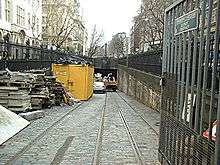Kingsway, London
Kingsway is a major road in central London, designated as part of the A4200. It runs from High Holborn, at its north end in the London Borough of Camden, and meets Aldwych in the south in the City of Westminster at Bush House. It was opened by King Edward VII in 1905.[1] Together Kingsway and Aldwych form one of the major north-south routes through central London linking the ancient east-west routes of High Holborn and Strand.




History
The road was purpose-built as part of a major redevelopment of the area in the 1900s. Its route cleared away the maze of small streets in Holborn such as Little Queen Street and the surrounding slum dwellings. However Holy Trinity Church, which was built in Little Queen Street was spared, whereas the Sardinian Embassy Chapel, an important Roman Catholic church attached to the Embassy of the Kingdom of Sardinia, was demolished to make way for the new street.
Plans were published by London County Council in 1898 and the road was formally opened in 1905. It is one of the broadest streets in central London at 100 feet (30 m) wide. There were several proposed names for the new street, including King Edward VII Street, Empire Avenue, Imperial Avenue and Connecticut Avenue. The name "Kingsway" was in honour of King Edward VII, who opened the street.[2]
It was unique in containing below it a tunnel for a tramway, which started just north of Southampton Row, passed beneath Aldwych and continued to the Thames Embankment: this Kingsway tramway subway joined the North and South London tram systems. In 1958 the disused tunnel was reopened at the southern end to make a new connection, the Strand Underpass, for light traffic between Waterloo Bridge and Kingsway in order to reduce congestion. Also beneath Kingsway was a branch of the Piccadilly tube line from Holborn to Aldwych station on the Strand. It was closed in 1994. Aldwych station is still used for television and film sets that require underground scenes. During the Second World War the branch was used to store art treasures from the British Museum, including the Elgin Marbles.[3]
On 1 April 2015, electrical cables under the pavement in Kingsway caught fire, leading to serious disruption in central London. The fire continued for the next two days, with flames shooting out of a manhole cover from a burst gas main,[4] before being extinguished.[5] Several thousand people were evacuated from nearby offices, and several theatres cancelled performances.[6][4][7] There was also substantial disruption to telecoms infrastructure.[8] On 8 April, press reports emerged stating that the fire may have been started as part of the 2015 Hatton Garden burglary.[9]
Buildings
The original buildings were built between 1903 and 1905. They were mostly mid-rises in stone, and in various styles including neoclassical and neo-Baroque. Many survive but some have been replaced. Notable buildings include:
- 61 Aldwych, previously Television House, the headquarters of Associated-Rediffusion Television
- Africa House
- Alexandra House
- Aviation House, formerly the Church of the Holy Trinity, in an Edwardian Baroque style.[10]
- Bush House, King's College London
- Civil Aviation Authority House (formerly known as Space House)[11]
- Kingsway Hall, Methodist mission hall opened in 1912 and from 1926 the church allowed HMV, EMI from 1931, to use it as a recording studio. In 1944 EMI were joined by Decca Records
- Victory House (the London Central Employment Tribunal)
- York House
- Various buildings of the London School of Economics
Transport
The closest tube stations are Holborn, and Temple (and formerly Aldwych, which closed in 1994).
As part of the redevelopment a tram tunnel was built underneath the road. The trams ceased to run in the mid-20th century and, since 1961, the southern end of the tunnel has been used by cars under the name of the Strand Underpass. The northern entrance to the tunnel still exists (with its tram lines still in situ, see image right) and can be found at the junction of Southampton Row and Vernon Place.
See also
- Kingsway telephone exchange, an underground telephone exchange in Chancery Lane.
- The King's Way, a song by the English composer Edward Elgar to a poem written by his wife, celebrates the opening of Kingsway.
References
- https://www.architecture.com/Explore/Locations/KingswayAndAldwych.aspx
- Weinreb, Ben and Hibbert, Christopher (1992). The London Encyclopaedia (reprint ed.). Macmillan. pp. 450–451.CS1 maint: uses authors parameter (link)
- Glover, John (1999). London's Underground. Hersham, England: Ian Allan. ISBN 0-7110-2636-X.
- "Holborn electrical fire causes mass evacuation". BBC News. Retrieved 2 April 2015.
- "Holborn underground fire extinguished". BBC News. 3 April 2015. Retrieved 4 April 2015.
- "Holborn fire costs London firms £40m: Full scale of damage and disruption revealed". Evening Standard. Retrieved 2 April 2015.
- O'Connor, Roisin. "Holborn fire: Kingsway remains closed as firefighters continue to tackle blaze burning under pavement in central London". The Independent. Retrieved 2 April 2015.
- Alex Scroxton (2 April 2015). "Kingsway fire brings down broadband services in London". Computerweekly. Retrieved 4 April 2015.
- Rachel Blundy and Sebastian Mann (8 April 2015). "Holborn fire 'could have been deliberately started by burglars responsible for Hatton Garden jewel heist'". Evening Standard.
- Historic England. "Church of the Holy Trinity (1379262)". National Heritage List for England. Retrieved 10 January 2016.
- Historic England. "Space House (now Civil Aviation Authority House) (1421847)". National Heritage List for England. Retrieved 10 January 2016.
Bibliography
- Simon Bradley and Nikolaus Pevsner, The Buildings of England, London 6: Westminster, 2003. ISBN 0-300-09595-3.